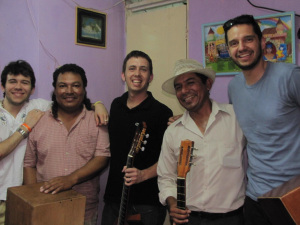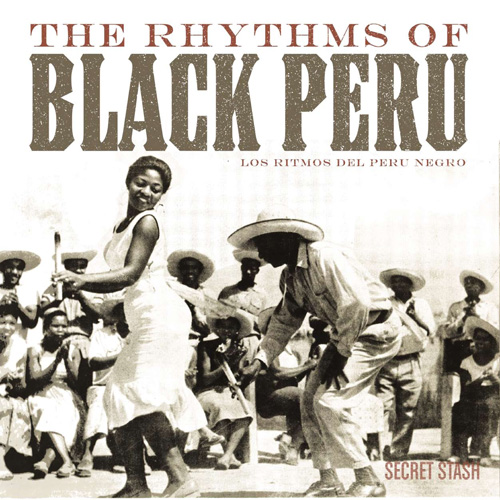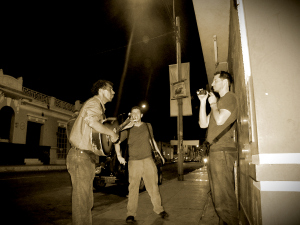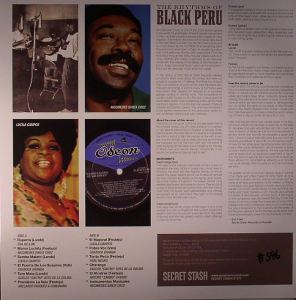Secret Stash Records’ Quest for
Afro-Peruvian Music
by Kim Haas
Cory Wong and Eric Foss are long-time friends and fellow musicians from small town Fridley, Minnesota. They first met when they were six years old. Cory plays the guitar and Eric enjoys drums and percussion. Growing up, the duo’s musical tastes would not suggest an eventual interest in Afro-Peruvian music. Eric recalled,“We grew up (listening to)….whatever you’d expect white kids from Minnesota to listen to…Metallica, Rage Against The Machine and other hard rock bands.”
As adults, the two friends formed the Secret Stash Record Label in 2009, releasing funk, jazz, and world music. To some degree, Secret Stash, was formed out of the many frustrations Eric experienced, working at several large record labels, “….I found myself disgusted with the industry; the way (large) retailers and distributors …. treat artists. ….walk into a retail store and you see a new album advertised (taking up lots of space)…like a whole wall (of the store). The retailer did not put it there because they love the artist. It is there because the distributor paid the retailer hundreds of thousands of dollars… It’s called Co-Op Advertising.”
Not only does Secret Stash approach the business of music differently but its sounds and recordings are decidedly unique for the 21st century. Nearly all of Secret Stash’s releases are on vinyl (accompanied by mp3s). Cory said, vinyl records offered the most accurate, recreated sound compared to CDs and other musical recording formats. The two music aficionados are focused and selective about tracks released under their label. “We …operate outside normal record business (models). Anything we put out, (we) are in love with it… I always feel that Secret Stash… offers a service. We are a filter……We can’t let things sift through that filter that don’t fit the criteria…”
Now that the days of working for large labels and distributors is over for Eric, he finds great satisfaction inSecret Stash’s business model. He described their approach to collaborating with other businesses as an important aspect of the company’s brand, “In Minneapolis, Tree House Records and Electric Fetus will play your record because it’s about loving music (not) how to squeeze money out of labels.”
Lima, Peru
The two friends are philosophically in sync in their pursuit of music for the Secret Stash label. They seek uncommon and often never released musical gems. In 2010, inspired by Cory’s mentor, Peruvian guitarist, Andres Prado, they traveled to Lima, Peru, in search of high-quality musical compositions and “to share Afro-Peruvian music with audiences who’ve never heard of Afro-Peruvian anything,” Cory explained.
In keeping with their nontraditional approach to business and music, Cory and Eric arrived in Peru’s capital city with minimal musical resources. The label’s website states, “With a portable recording studio, an interpreter, and no preplanned engagements or sessions they hit the streets. Within one week’s time they put together a band they called Peña.” (Peña is a meeting place or grouping of artists/musicians. It is also the name of the 17 track album the friends recorded in Lima.)
Cory and Eric were impressed by the overwhelming generosity of the Peruvian musicians who extended invitations to use their homes as recording studios when they learned the Minnesotans were without a traditional recording studio. Peruvian hospitality also included offerings of time and resources in support of recording music for Peña. “Peruvian people have pride in their culture unlike anything I’ve seen in the States,” cited Eric.“People down there don’t necessarily think of themselves as musicians…..everybody just kind of plays. And I think it is so ingrained in the culture…. Cory added, “It’s also just a street thing. They come from the school of the streets. It’s just very raw, very real and very genuine, genuinely played music. A lot of times it’s not technically accurate but they’ve got so much life and so much passion in it that it trumps any technical quarries…..”

A picture after one of our recording sessions….
L to right: Unai (translator), Larry (cajon, vox), Cory (guitar), Alberto (guitar, vox), Eric (video).
Secret Stash’s website characterizes Afro-Peruvian music as “…one of the most elusive genres (of music) in the world. Not only is it practically unheard outside the borders. The roots of this music date back to the mid 1500s, but over time Afro-Peruvian culture and its music faded. So much so that by the mid 1900s, most Afro-Peruvians had never even seen a cajón (a wooden box used as a drum).”
Although the cajón may not have been known throughout Peru just a century ago, within the last decade, Afro-Peruvian music has experienced a renaissance and heightened global awareness. The cajón has become the symbol of Afro-Peruvian music. And while the instrument is increasingly revered, the origins tell of a more humble beginning in Chincha and El Carmen, Peru; the heartland of Afro-Peruvian culture and society. These areas, about two and a half hours south of Lima, were the locations of the mines, plantations and haciendas where enslaved African laborers worked. Seeking to reduce the risk of insurrections, enslavers prohibited workers from playing instruments. Enslaved Africans responded to this restriction with creativity. Eric elaborates, “When the slaves had boxes for carrying around fruit that they were picking in the fields, when no one was looking, they’d empty them out, sit on top of it and hit it and boom you’ve got a drum.” This is how the ingenious cajón evolved. Eric marvels at how something so seemingly simple became so celebrated, “All the cajón is, is a box. The mind opening thing to learn is that it’s just a box, yet it can be an instrument with so much tone and texture.”
It wasn’t just the cajón that morphed from a utilitarian existence into a musical instrument. The cajita (little box) originally was a staple in Peru’s Catholic Church. Worn around the neck, it was an offering box for parishioners. Afro-Peruvians also found a way to make intoxicating music from a donkey’s jaw bone (la quijada de burro) which Eric said “….makes this really cool, funky sound.”
Cory describes Afro-Peruvian music as consisting of the cajón and the nylon string guitar. Next, he says, add the cajita, the quijada and Afro-Peruvian vocals which frequently and graphically depict Peruvian enslavement, emitting enticing sounds, conjuring visuals and synthesizing the unique musical combinations that are both awe-inspiring and distinctive.
The Rhythms of Black Peru
As an outcome of the album Peña, Cory and Eric produced several other musical projects, including The Rhythms of Black Peru, “a collection of some of the most important Afro-Peruvian recordings of all time.” Eric described The Rhythms of Black Peru as “a good representation of the different styles of Afro-Peruvian music and rhythms which are: the festejo, lando and panalivio.” For Cory, these rhythms are unmistakably Afro-Peruvian.
Tracks by Afro-Peruvian singers Eva Ayllon, Lucila Campos and the late Nicomedes Santa Cruz, considered the greatest proponent of Afro-Peruvian culture, contributed to five of The Rhythms of Black Peru’s dozen recordings.
Santa Cruz’s stature in Afro-Peruvian culture is legendary. His wide-ranging talents were varied and included work as a poet, journalist and musician. He dedicated his life to increasing awareness of Peru’s African roots. Nearly 50 years ago, Santa Cruz recorded a four-album set called Cumanana, which is now celebrated as the bible of Afro-Peruvian music. Nicomedes Santa Cruz’s family is pleased with efforts to broaden the appeal of Afro-Peruvian music. According to Eric, “Anytime they see someone trying to help further the legacy of Nicomedes. They are pretty excited and that’s always really nice to experience.”
Individually, The Rhythms of Black Peru, represent multiple decades of Afro-Peruvian musical recordings. With a few technical tweaks, this compilation of previously recorded songs, sounds as if it were recorded contemporaneously. Listeners will delight in the breadth and depth of Afro-Peruvian musical genres.
Since this compilation showcases a diverse collection of Afro-Peruvian sounds from different decades, what was the process for deciding on the album cover photo? Eric explained the thinking behind the selection, “It’s very hard when you are doing a compilation to figure out what’s the one photo that’s going to typify and express what this record is. It should come from a really deep source that’s well connected. (The album cover)… is taken from the inside of a Nicodemes Santa Cruz record. One of my favorite records of all time, any genre, any time, any place. I’m absolutely in love with it. It’s called Socabón.”
The black and white photo depicts a man and woman performing El Alcatraz, a flirtatious cat and mouse dance which has a somewhat fiery ending as Eric explains, “…the woman will hang a piece of cloth or paper off the back of her dress, they (she and the man) are dancing to a really intense festejo rhythm. When you see it live, it’s awesome. What the man does is he takes a candle, he lights it. He’s basically going to try and set that paper on fire. Her job is to play hard to get, the basic interaction between men and women. Eventually, he gets her and boom that thing goes up in flames, then its Stop, Drop and Roll. It’s quite entertaining.”
Whether through music or dance, Peru’s African roots are undeniably rich and strong. Through their unconventional approaches, Cory and Eric are helping to uncover and promote one of Peru’s most glorious cultural treasures – Afro-Peruvian music.
>via: http://losafrolatinos.com/2013/07/27/secret-stash-records-quest-for-afro-peruvian-music/





